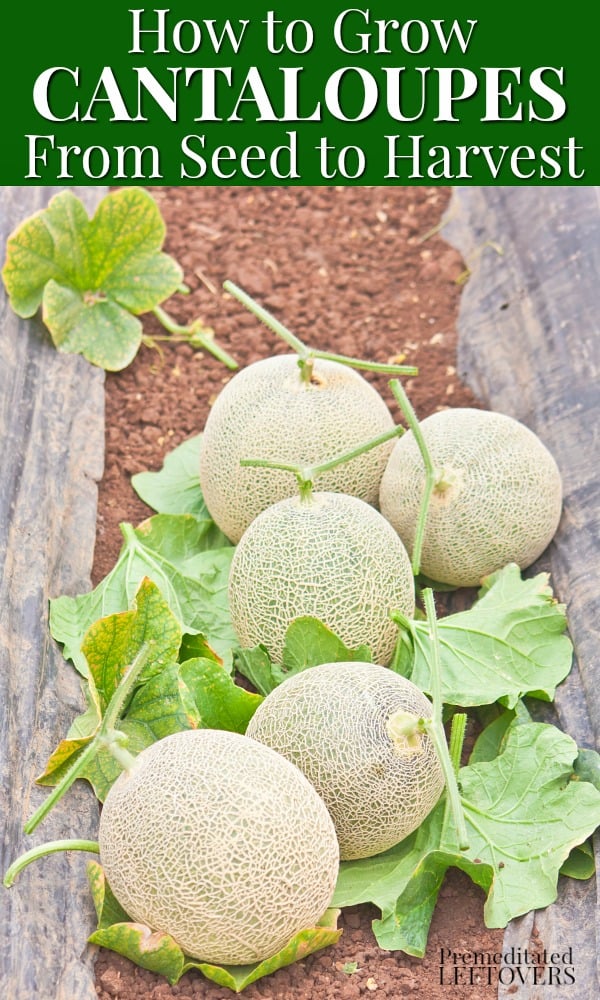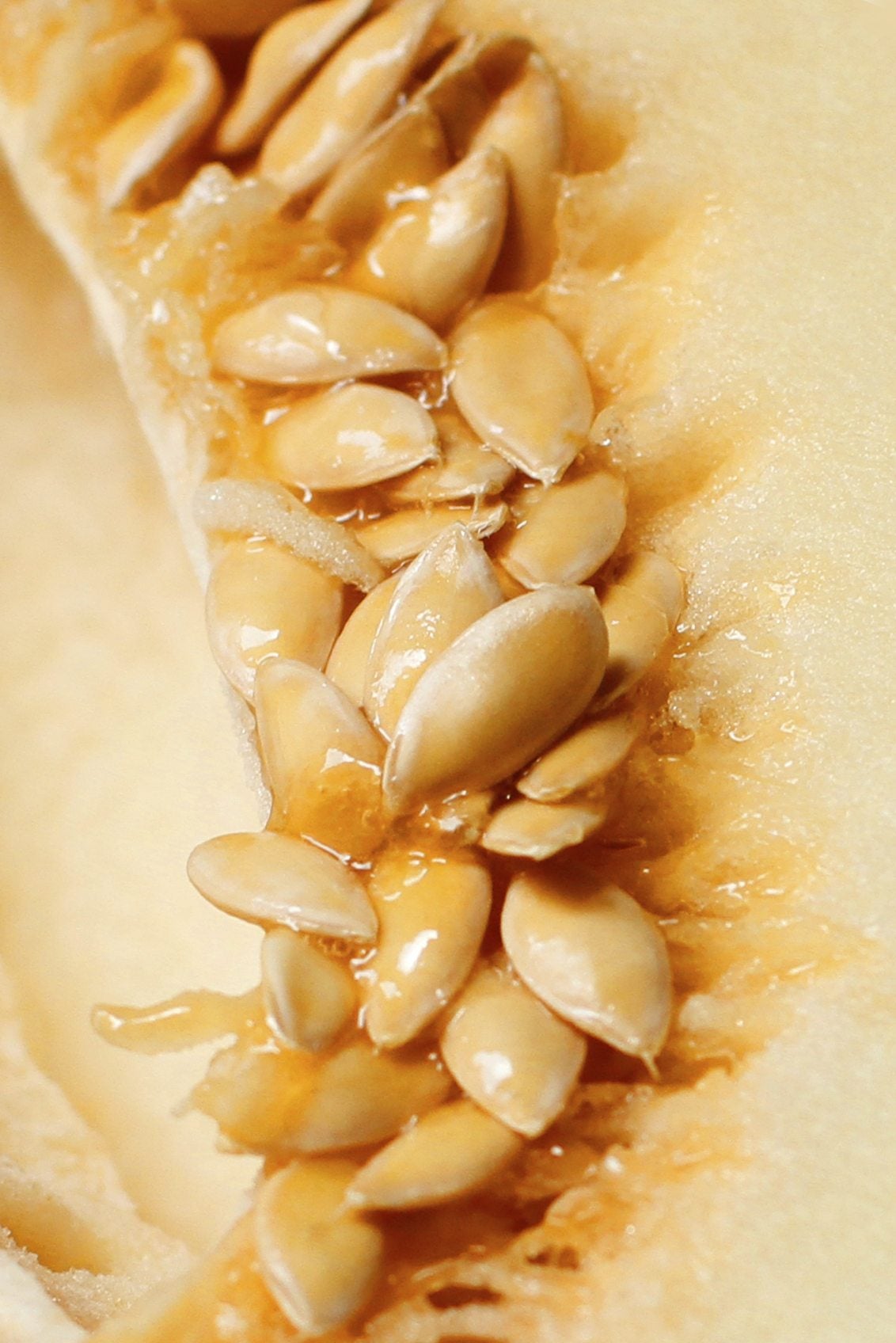To harvest cantaloupe seeds, cut the ripe fruit in half and scoop out the seeds. Cantaloupes, also known as muskmelons, are delicious and refreshing summer fruits.
They are not only a tasty treat, but they also contain a plethora of nutrients and vitamins like vitamin A and C. Whether you grew them in your garden or bought them from the market, you may be curious about how to harvest the seeds for future planting or snacking.

Credit: premeditatedleftovers.com
Luckily, it’s a relatively simple process. We will discuss the steps to efficiently harvest cantaloupe seeds to enjoy their goodness and save them for later. So let’s dive in and learn how to collect cantaloupe seeds like a pro!
How to Harvest Cantaloupe Seeds : Step by Step Guide
Determining Ripe Cantaloupes For Seed Harvesting
Inspecting the outer appearance of cantaloupes is the first step in determining if they are ripe for seed harvesting. Look for uniform coloring on the skin, as well as a dull rather than shiny surface. Ripe cantaloupes should also have a netting pattern on the skin that is well-defined.
Next, sniff the cantaloupes for a sweet aroma. A ripe cantaloupe will have a strong, sweet scent. Avoid cantaloupes that have a sour or fermented smell, as they may be overripe or spoiled.
Lastly, check the texture of the skin for firmness. Press gently on the skin with your thumb – it should give slightly but still remain firm. Avoid cantaloupes that feel too soft or mushy, as this indicates overripeness.
Following these steps will help ensure that you harvest cantaloupe seeds from ripe and high-quality fruits. Remember to save the seeds from the ripest and best-tasting cantaloupes for the best results in your next gardening season.
Extracting Cantaloupe Seeds
Extracting cantaloupe seeds:
Start by cutting the cantaloupe in half lengthwise. Once cut, use a spoon to scoop out the seeds from the center of each half. You can also use your hands to remove any attached flesh from the seeds.
After scooping out the seeds, place them in a sieve or colander. Rinse them under cool water to remove any remaining flesh or debris. Shake off the excess water and spread the seeds on a paper towel or a clean, dry surface to dry them thoroughly.
Once the seeds are completely dry, they can be stored in an airtight container or a sealed envelope. Make sure to label the container with the type of seed, as well as the date of harvest. Store the seeds in a cool, dry place until you are ready to plant them.
Washing And Drying Cantaloupe Seeds
Lorem ipsum dolor sit amet, consectetur adipiscing elit. Etiam vehicula sed tellus in tristique. Quisque dapibus felis et nibh pellentesque lacinia. Vestibulum eu sollicitudin est. Suspendisse maximus dictum felis, nec pharetra arcu bibendum at. Donec vel dui erat. Donec aliquet, turpis a consequat auctor, mauris ipsum ullamcorper sapien, ut ultricies turpis massa eu nunc.
Pellentesque sed tellus eu risus vulputate consectetur sit amet at mauris. Donec auctor rhoncus porttitor. Pellentesque commodo massa ut turpis blandit, ut aliquam orci ullamcorper. Sed suscipit bibendum turpis id fermentum. Morbi sollicitudin volutpat metus, nec feugiat dui ullamcorper at. Ut vestibulum nisl mi, vel tincidunt lacus luctus a.
| Subheading |
|---|
| Rinsing the seeds under cool water |
| Removing any pulp or flesh from the seeds |
| Spreading the seeds out on a paper towel or mesh screen to dry |
Praesent et elit non felis molestie porttitor. Vivamus lobortis sem eget imperdiet rutrum. Mauris efficitur sem non lectus bibendum fermentum. Fusce sagittis magna risus, eget fermentum nulla ullamcorper vel. Integer a sodales urna. Aliquam commodo consectetur massa ac suscipit. Pellentesque habitant morbi tristique senectus et netus et malesuada fames ac turpis egestas. Donec sit amet magna ultrices, sodales dolor sed, fermentum elit. Sed eu aliquet eros. Duis fermentum tristique leo, et molestie felis maximus quis. Nunc in nunc eget ante congue fermentum commodo in justo. Vestibulum ante ipsum primis in faucibus orci luctus et ultrices posuere cubilia curae; Sed sed semper nulla, et cursus velit.
Separating Viable Seeds From Non-viable Ones
When harvesting cantaloupe seeds, it is important to separate the viable seeds from the non-viable ones. Discard any seeds that appear deformed or discolored, as these are unlikely to germinate successfully. To further identify non-viable seeds, perform a float test. Fill a bowl with water and gently place the seeds in it. Viable seeds will sink to the bottom, while non-viable seeds will float. Collect the seeds that sink and discard the ones that float. This simple test helps ensure that only viable seeds are saved for future planting.
Drying Seeds Thoroughly
After harvesting cantaloupe seeds, it is crucial to dry them thoroughly before storing. To do this, start by leaving the seeds to air dry for a few days. Spread them out on a clean surface, such as a baking sheet or a paper towel, ensuring they are not overlapping. This will allow air circulation and speed up the drying process.
Make sure to place the seeds in a warm, dry location away from direct sunlight. Check on them occasionally and stir them gently to promote even drying. The aim is for the seeds to be completely dry before storage, as any residual moisture can lead to mold and rot.
Once the seeds are dry, store them in an airtight container, such as a glass jar or a zip-top bag. Label the container with the date of harvest and the variety of cantaloupe. Store the container in a cool, dark place to maintain seed viability.
Storing Cantaloupe Seeds
When storing cantaloupe seeds, it is important to use airtight containers to ensure their long-term viability. These containers will prevent moisture and air from getting inside, which can cause the seeds to spoil or lose their ability to germinate. Additionally, it is crucial to keep the seeds in a cool, dark place, such as a pantry or cellar. Exposure to heat and light can damage the seeds and reduce their viability.
To keep track of the seeds and their freshness, it is recommended to label the containers with the date and variety of seeds. This way, you can easily identify and use the oldest seeds first, while ensuring that you always have a fresh supply for future planting. By following these storage practices, you can harvest and store cantaloupe seeds successfully for multiple seasons.
Testing Seed Viability
Conducting a germination test to check seed viability is an important step in the process of harvesting cantaloupe seeds. To perform this test, start by taking a small group of seeds and placing them in a damp paper towel or coffee filter. Make sure the seeds are spread out evenly and then fold the towel or filter to cover them. Place the folded towel or filter in a sealed plastic bag and keep it in a warm location.
After a few days, check for signs of germination. If the seeds have started to sprout, it indicates that they are viable and can be harvested for planting. However, if there is no germination after a week or so, it is likely that the seeds are not viable and should not be saved.
Remember to label and store the viable seeds in a cool, dry place until you are ready to use them for planting. By testing seed viability, you can ensure that you are saving and using only the best quality seeds for future crops of cantaloupe.
Properly Preparing Seeds For Planting
In order to properly prepare cantaloupe seeds for planting, it is important to follow a few key steps. One of these steps is scarifying the seeds to enhance germination. Scarification helps to break the seed coat, allowing moisture to penetrate and the seed to sprout more easily. To scarify the seeds, carefully nick the outer coat of each seed with a sharp knife or rub them gently with sandpaper.
Another important step is soaking the seeds in warm water prior to planting. This soaking process helps to soften the seed coat and encourages faster germination. Simply place the seeds in a bowl of warm water and let them soak for 24 hours before planting. By properly preparing your cantaloupe seeds, you can increase the chances of successful germination and a bountiful harvest.
Storing Seeds Long-term
Utilizing a seed vault for extended storage is a great option to ensure the long-term viability of your cantaloupe seeds. These vaults provide optimal conditions for seed preservation, including low moisture and temperature.
Monitoring and rotating stored seeds regularly is essential to maintain their viability. It’s important to check the moisture levels periodically and adjust them if necessary. Additionally, ensuring that the seeds are tightly sealed in airtight containers will protect them from any potential exposure to moisture or pests.
When storing your cantaloupe seeds, labeling them with the date of harvest is crucial for maintaining accurate records. This information will help you keep track of the seeds’ age and determine if it’s time to refresh your seed collection.
| Key Points: |
|---|
| Utilize a seed vault for extended storage. |
| Monitor and rotate seeds regularly. |
| Label seeds with the date of harvest. |
By following these practices, you can effectively store your cantaloupe seeds long-term and ensure their viability for future planting seasons.
Frequently Asked Questions Of How To Harvest Cantaloupe Seeds
How Do You Save Seeds From Cantaloupe?
To save seeds from cantaloupe, scoop out the seeds from the ripe fruit. Rinse them thoroughly and let them dry on a paper towel for a week. Once dry, store them in a cool, dry place in a labeled envelope until you’re ready to plant them.
Can You Take Seeds From A Cantaloupe And Plant Them?
Yes, you can plant seeds from a cantaloupe. Harvest the seeds, rinse off the pulp, dry them, and plant them in well-drained soil.
What Month Do You Plant Cantaloupe Seeds?
Cantaloupe seeds are typically planted in the springtime, specifically in the month of April.
How Long Does Cantaloupe Take From Seed To Harvest?
Cantaloupe takes about 80-90 days from seed to harvest.
Conclusion
Harvesting cantaloupe seeds is a simple and rewarding process. By following these easy steps, you can save and store seeds for future planting. Remember to wait until the cantaloupe is fully ripe, scoop out the seeds, rinse and dry them thoroughly, and store them in a cool, dry place.
With these tips, you can enjoy a bountiful harvest of cantaloupe and continue growing this delicious fruit in your garden. Happy seed saving!

